Thanks for attending the Culinary Breeding Network and participating in the Seed-O-Matic game. Here you can find more information on the Seed-O-Matic and the seeds in the packet that you received.
The Seed-O-Matic was generously lent to us by the Center for Genomic Gastronomy. All of the seed in the Seed-O-Matic was released under the Open Source Seed Initiative (OSSI) Pledge:
“You have the freedom to use these OSSI- Pledged seeds in any way you choose. In return, you pledge not to restrict others’ use of these seeds or their derivatives by patents or other means, and to include this Pledge with any transfer of these seeds or their derivatives.”
The Pledge ensures the 4 Seed Freedoms:
- The freedom to save or grow seed for replanting or for any other purpose.
- The freedom to share, trade, or sell seed to others.
- The freedom to trial and study seed and to share or publish information about it.
- The freedom to select or adapt the seed, make crosses with it, or use it to breed new lines and varieties.
Learn more about the varieties featured below, and check out the nearly 400 OSSI Pledged varieties in our Seed database. If you like the work we are doing, please consider a donation!
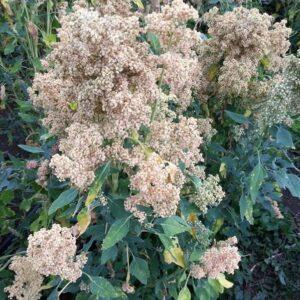 ‘Mint Vanilla’
‘Mint Vanilla’
Quinoa
Bred by Frank Morton, Wild Garden Seed
Mint Vanilla is a recent variety released by Frank, selected from his ‘Brightest Brilliant’ quinoa population. Mint Vanilla has bright white seed heads with very white seeds in a green-tinged panicle. It is well adapted to coastal growing regions. Seed available here!
Quinoa is Self-Pollinating and Mint Vanilla is an Open Pollinated variety
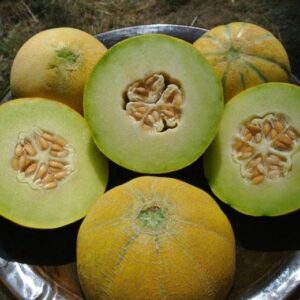 ‘Farthest North Galia’
‘Farthest North Galia’
Melon
Bred by Andrew Still, Adaptive Seeds
Farthest North Galia is a genepool mix that has been selected for small, round, green-fleshed melons. Our goal is to breed a small fruited super early, super sweet galia/passport type melon sometimes referred to as tropical melons. The color and size are mostly stable so far, however the rind style and flavor profile is still variable. Some taste a lot like the galia-type and some still have a charentais-like flavor, which is also good. A modern landrace that can still be selected by all you seed savers to create many new varieties. Here’s to open source genetics! Seed Available Here!
Melons are Out-Crossing and Farthest North Galia is an Open-Pollinated variety
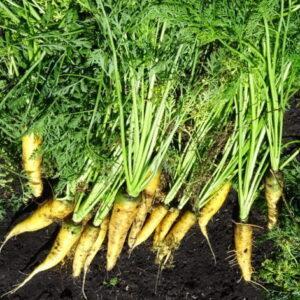 ‘Wisconsin Open Source Composite – Yellow’
‘Wisconsin Open Source Composite – Yellow’
Carrot
Bred by Claire Luby and Irwin Goldman, University of Wisconsin – Madison
The goal of breeding the Wisconsin Open Source Composite populations was to take commercially available cultivars that had freedom to operate for breeding and create diverse carrot populations based on market class and root color. These composite populations are meant to represent some of the diversity present in commercially available carrot germplasm that is available to use in breeding. The WI-OSC Yellow population is characterized by variation in the intensity of yellow color, or accumulation of xanthophylls, in the roots with occasional white and orange roots appearing. Some roots have green crowns. Roots vary in shape and are generally ‘Danvers’ or ‘Belgian’, with relatively pronounced shoulders and tapered roots. Tops are very strong and vigorous. Parental material included: Amarillo, Solar Yellow, Jaune du Doubs, and Yellow Sun. This population has been developed for two generations under organic growing conditions.
Carrots are Out-Crossing and this population is a diverse, Open Pollinated variety
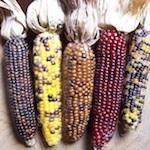 ‘Cassiopeia’
‘Cassiopeia’
Popcorn
Bred by Don Tipping, Siskiyou Seeds
A southern Oregon original in development over the past 15 years. Originating with the old Coche de Pueblo strain we crossed it with 4 other varieties. Cassiopeia combines the best traits of 5 different heirloom popcorns. Selected for early maturity, large ear size and multiple ears per plant (up to 5), it is multicolored, tall (8-9’) and beautiful. Let dry in the field and cure on the cob indoors for a few months before popping. Plants exhibit a range or red, purples and greens in their stalks, foliage, tassels, husks and silks. Will not cross with sweet or flour corns. * Please note that in order to pop successfully popcorn must have an adequately long season to mature fully. Harvest once husks are dry on the plant. If frost kills plants before maturity you can pull them from the roots, bundle and let finish under cover. Let ears dry fully after shucking (usually 2-3 months) before trying to pop. (And no it doesn’t work to try and pop it on the cob. they just burn!) Seed available here!
Corn is Cross-pollinating and Cassiopeia is an Open Pollinated variety
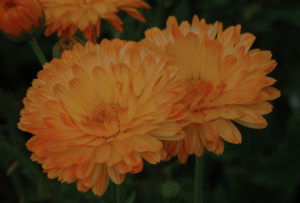 ‘Orange Sherbet’
‘Orange Sherbet’
Calendula
Bred by Frank Morton, Wild Garden Seed
Brilliant high toned orange doubled calendulas. These come in a variety of petal lengths and widths, creating textural diversity within a color theme inspired by creamed frozen fruit dessert. This color lights up your face. Seed available here!
Calendula is Cross-pollinating and Orange Sherbet is an Open Pollinated variety
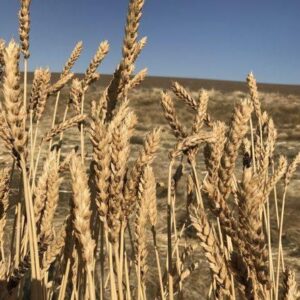 ‘Elwha River’
‘Elwha River’
Winter Spelt
Bred by Kevin Murphy, Washington State University
Spelt is Self-Pollinating and Elwha River is an Open- Pollinated variety
